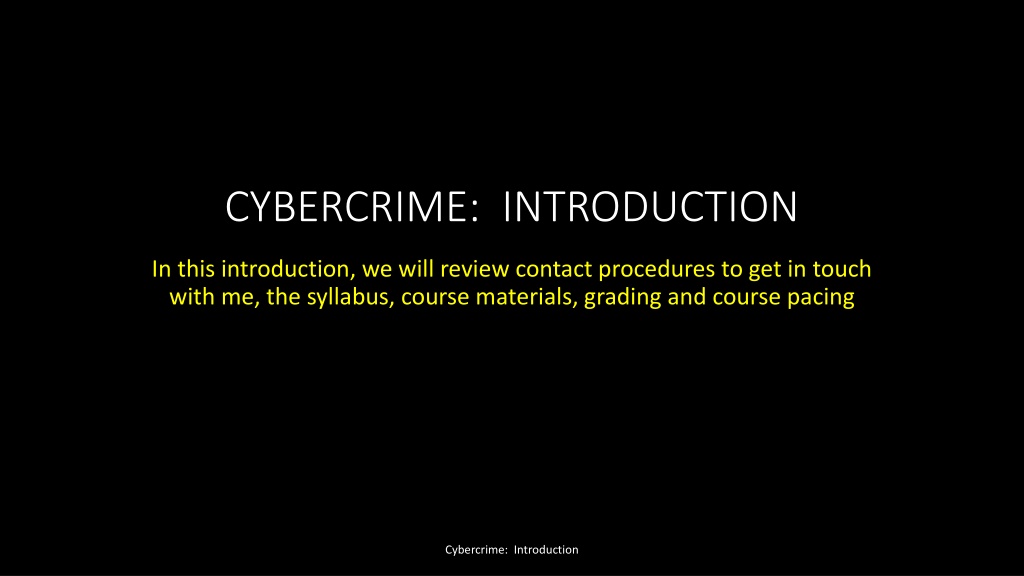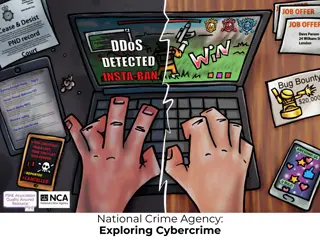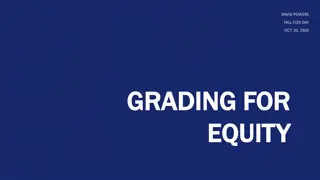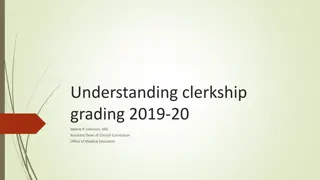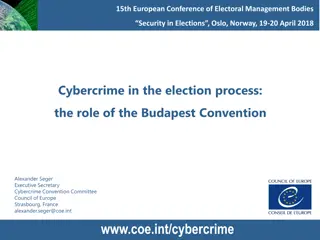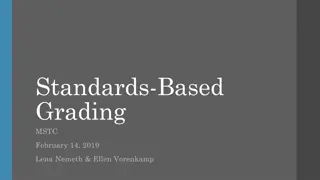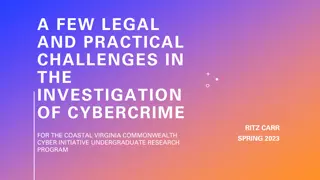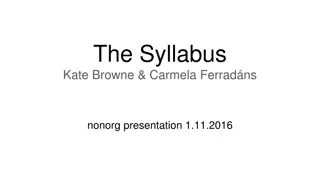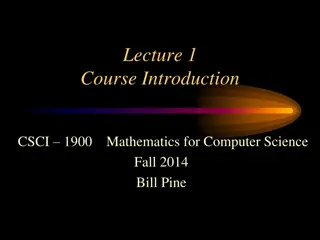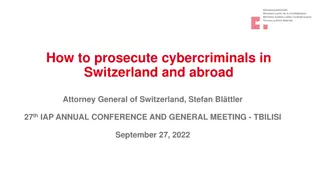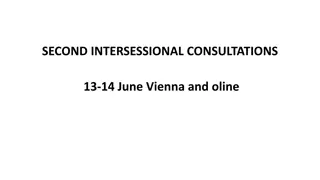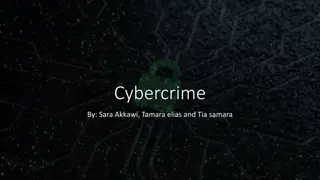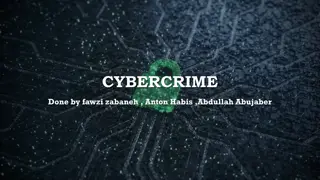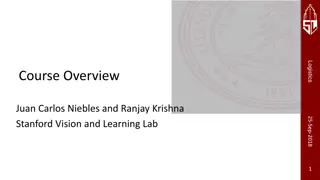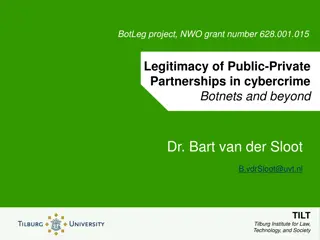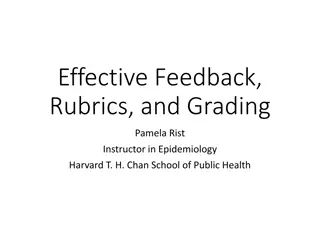Cybercrime Course Overview: Syllabus, Materials, and Grading
This Cybercrime course overview introduces Dr. Matthew Petrocelli as the instructor and details the syllabus organization, course materials, and grading system. The course is structured into 10 learning units covering various aspects of cybercrime, including information assurance, cyber law, investigation, and more. Students are provided with online course materials, PowerPoint slides, and lectures. Grading consists of three examinations worth a total of 225 points, with specific content coverage and time limits for each exam. Further engagement with linked articles and videos is recommended for a comprehensive learning experience.
Download Presentation

Please find below an Image/Link to download the presentation.
The content on the website is provided AS IS for your information and personal use only. It may not be sold, licensed, or shared on other websites without obtaining consent from the author. Download presentation by click this link. If you encounter any issues during the download, it is possible that the publisher has removed the file from their server.
E N D
Presentation Transcript
CYBERCRIME: INTRODUCTION In this introduction, we will review contact procedures to get in touch with me, the syllabus, course materials, grading and course pacing Cybercrime: Introduction
CYBERCRIME Welcome to the course Instructor: Email: Address: Dr. Matthew Petrocelli mpetroc@siue.edu Southern Illinois University Edwardsville Criminal Justice Studies Program Peck Hall, Box 1455 Edwardsville, IL 62026 618-650-3296 Phone: Cybercrime: Introduction
CYBERCRIME SYLLABUS: COURSE ORGANIZATION The course is divided into 10 learning units: 1. Introduction to cybercrime 2. Information Assurance 3. IT-Enabled abuse, attacks and crimes 4. Computer abusers and cybercriminals 5. Theories of IT-enabled abuse and crime 6. The social and economic impact of cybercrimes 7. Emerging and controversial cybercrime issues 8. Cyber law and regulations 9. Investigation and prosecuting cybercrimes 10. Selected federal cybercrime statutes Cybercrime: Introduction
CYBERCRIME SYLLABUS: COURSE MATERIALS This is a self contained, online course meaning that all materials you will need for your tests are included in the PowerPoint slides and associated lectures There is no text book you are required to purchase or rent But throughout each Learning Unit, I have linked certain articles and videos These articles and videos will enhance your understanding of course material, but they are not testable. Meaning, I will not ask you any test questions derived from a linked article or video Still, I highly recommend that you engage these readings and videos for a fuller, more comprehensive learning experience Cybercrime: Introduction
CYBERCRIME SYLLABUS: GRADING There are three examinations you must take to complete this course The course is worth a total of 225 points Examination #1 This test will include information from Learning Units 1, 2 and 3 The test will have 81 multiple choice and true/false questions Each question is worth 1 point, so Exam 1 is 81 points toward the total course point value (225 points) You will have 85 minutes to complete this test, and then the test will automatically shut off You will not be able to proceed to Learning Unit 4, or any of the other proceeding Learning Units, until you have taken Examination #1 Cybercrime: Introduction
CYBERCRIME SYLLABUS: GRADING Examination #2 This test will include information from Learning Units 4, 5 and 6. The test is noncumulative, meaning you will not be tested on material from previous Learning Units The test will have 75 multiple choice and true/false questions Each question is worth 1 point, so Exam 2 is 75 points toward the total course point value (225 points) You will have 80 minutes to complete this test and then the test will automatically shut off You will not be able to proceed to Learning Unit 7, or any of the other proceeding Learning Units, until you have taken Examination #2 Cybercrime: Introduction
CYBERCRIME SYLLABUS: GRADING Examination #3 This test will include information from Learning Units 7, 8, 9 and 10 The test is noncumulative, meaning you will not be tested on material from previous learning units The test will have 69 multiple choice and true/false questions Each question is worth 1 point, so Exam 3 is worth 69 point toward the total course point value (225 points) You will have 75 minutes to complete this test and then the test will automatically shut off After you have taken Exam 3, you are finished with the course Cybercrime: Introduction
CYBERCRIME SYLLABUS: GRADING The grading summary is: Exam 1 = 81 points Exam 2 = 75 points Exam 3 = 69 points Total = 225 points The grade scale to determine your final letter grade is as follows: 202-225 points = A 180 -201 points = B 157 - 179 points = C 135 156 points = D 134 points and below = F Please note that your course grade is based entirely on test scores. There is no extra credit Cybercrime: Introduction
CYBERCRIME SYLLABUS: CONTACTING THE PROFESSOR All contact with me (questions, concerns, etc.) will be conducted via email: mpetroc@siue.edu Please put Cybercrime in the subject box I will answer emails during normal business hours (9am-5pm) on weekdays only (Monday, Tuesday, Wednesday, Thursday and Friday) I will do my best to answer all emails within a 2 hour time frame. Do not expect an immediate response It is your responsibility to check your email regularly for course updates, information, etc. Cybercrime: Introduction
CYBERCRIME SYLLABUS: COURSE PACING This is a self paced course, meaning you can move forward and toward completion at your convenience The course MUST be completed in total (meaning all 3 examinations have been taken) by the last day of the semester at the close of business (5pm) There will be no exceptions to this rule Work hard, study and do well Please proceed to Learning Unit 1 Cybercrime: Introduction
CYBERCRIME Course references: Clifford, Ralph. 2006. Cybercrime: The Investigation, Prosecution and Defense of a Computer-Related Crime. Second Edition. Carolina Academic Press. Holt, Thomas. 2013. Crime On-Line: Correlates, Causes and Context. Second Edition. Carolina Academic Press. McQuade, Samuel. 2006. Understanding and Managing Cybercrime. Pearson. Yar, Majid. 2013. Cybercrime and Society. Second Edition. Sage Publications. Cybercrime: Introduction
